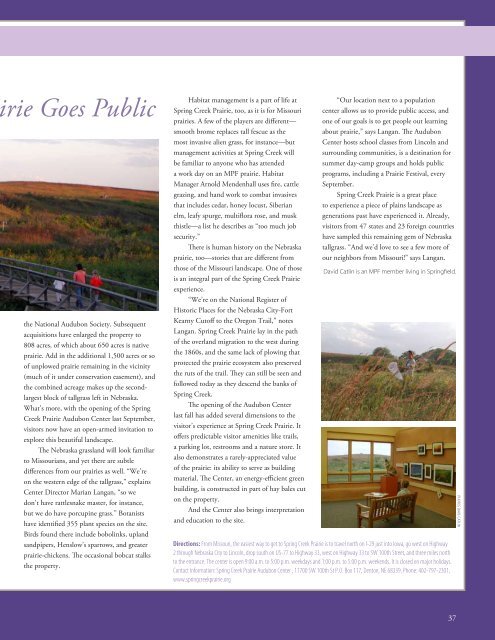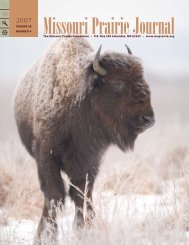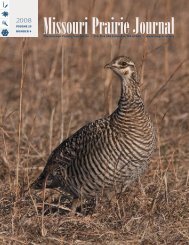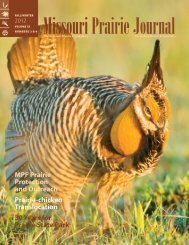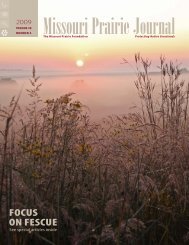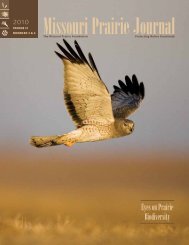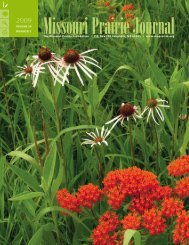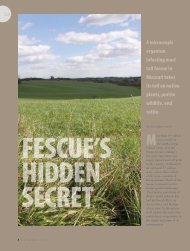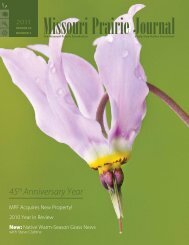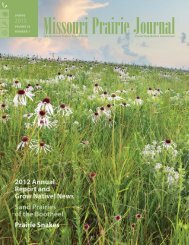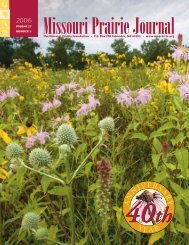Summer 2007: Volume 28, Number 3 - Missouri Prairie Foundation
Summer 2007: Volume 28, Number 3 - Missouri Prairie Foundation
Summer 2007: Volume 28, Number 3 - Missouri Prairie Foundation
- No tags were found...
Create successful ePaper yourself
Turn your PDF publications into a flip-book with our unique Google optimized e-Paper software.
ie Goes Publicthe National Audubon Society. Subsequentacquisitions have enlarged the property to808 acres, of which about 650 acres is nativeprairie. Add in the additional 1,500 acres or soof unplowed prairie remaining in the vicinity(much of it under conservation easement), andthe combined acreage makes up the secondlargestblock of tallgrass left in Nebraska.What’s more, with the opening of the SpringCreek <strong>Prairie</strong> Audubon Center last September,visitors now have an open-armed invitation toexplore this beautiful landscape.The Nebraska grassland will look familiarto <strong>Missouri</strong>ans, and yet there are subtledifferences from our prairies as well. “We’reon the western edge of the tallgrass,” explainsCenter Director Marian Langan, “so wedon’t have rattlesnake master, for instance,but we do have porcupine grass.” Botanistshave identified 355 plant species on the site.Birds found there include bobolinks, uplandsandpipers, Henslow’s sparrows, and greaterprairie-chickens. The occasional bobcat stalksthe property.Habitat management is a part of life atSpring Creek <strong>Prairie</strong>, too, as it is for <strong>Missouri</strong>prairies. A few of the players are different—smooth brome replaces tall fescue as themost invasive alien grass, for instance—butmanagement activities at Spring Creek willbe familiar to anyone who has attendeda work day on an MPF prairie. HabitatManager Arnold Mendenhall uses fire, cattlegrazing, and hand work to combat invasivesthat includes cedar, honey locust, Siberianelm, leafy spurge, multiflora rose, and muskthistle—a list he describes as “too much jobsecurity.”There is human history on the Nebraskaprairie, too—stories that are different fromthose of the <strong>Missouri</strong> landscape. One of thoseis an integral part of the Spring Creek <strong>Prairie</strong>experience.“We’re on the National Register ofHistoric Places for the Nebraska City-FortKearny Cutoff to the Oregon Trail,” notesLangan. Spring Creek <strong>Prairie</strong> lay in the pathof the overland migration to the west duringthe 1860s, and the same lack of plowing thatprotected the prairie ecosystem also preservedthe ruts of the trail. They can still be seen andfollowed today as they descend the banks ofSpring Creek.The opening of the Audubon Centerlast fall has added several dimensions to thevisitor’s experience at Spring Creek <strong>Prairie</strong>. Itoffers predictable visitor amenities like trails,a parking lot, restrooms and a nature store. Italso demonstrates a rarely-appreciated valueof the prairie: its ability to serve as buildingmaterial. The Center, an energy-efficient greenbuilding, is constructed in part of hay bales cuton the property.And the Center also brings interpretationand education to the site.“Our location next to a populationcenter allows us to provide public access, andone of our goals is to get people out learningabout prairie,” says Langan. The AudubonCenter hosts school classes from Lincoln andsurrounding communities, is a destination forsummer day-camp groups and holds publicprograms, including a <strong>Prairie</strong> Festival, everySeptember.Spring Creek <strong>Prairie</strong> is a great placeto experience a piece of plains landscape asgenerations past have experienced it. Already,visitors from 47 states and 23 foreign countrieshave sampled this remaining gem of Nebraskatallgrass. “And we’d love to see a few more ofour neighbors from <strong>Missouri</strong>!” says Langan.David Catlin is an MPF member living in Springfield.Directions: From <strong>Missouri</strong>, the easiest way to get to Spring Creek <strong>Prairie</strong> is to travel north on I-29 just into Iowa, go west on Highway2 through Nebraska City to Lincoln, drop south on US-77 to Highway 33, west on Highway 33 to SW 100th Street, and three miles northto the entrance. The center is open 9:00 a.m. to 5:00 p.m. weekdays and 1:00 p.m. to 5:00 p.m. weekends. It is closed on major holidays.Contact Information: Spring Creek <strong>Prairie</strong> Audubon Center , 11700 SW 100th St P.O. Box 117, Denton, NE 68339, Phone: 402-797-2301,www.springcreekprairie.orgPhotos Dave Catlin37


